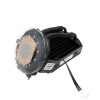
Believe it or not, these little guys are capable of cooling a 2687w v2! In fact they are mandatory for that processor, which is a 150W TDP processor. As you can see, its a closed system. But very easy to take the sleeve off and drain, flush and fill with gallium (galinstan) and get right to testing. This is probably the most compact way in which I can create a prototype design to test and get meaningful results from, since I can always go back and reference performance characteristics with water as a coolant as well.
This is going to be a sacrificial test. Nothing is going to suffer from LME but I will probably have to chuck the gallium after testing is complete because it will react much more readily with copper, of which 99% of the radiator is. It wont compromise the cooling capacity of the LM, however, which is why it's applicable to test in this scenario and I can still get accurate results I can then use towards a slightly larger loop.

First off, I am 100% serious about this and excited to get the research done and assemble needed supplies and technical data to get going on it as quickly as possible. The rise of LM as a thermal paste peaked my interest in using Galinstan as a liquid metal coolant in my z820 so I don't really need to buy anything other than the gallium alloy, Galinstan, to build my prototype. This project is not practical in any sense of the word, fyi before you try to shut me down I know all this. I have like 5 extra radiators in storage so if I kill a couple testing my theory its no problem. Also note, z820 radiators are compact and self contained, making it ideal for testing liquid metal as a viable coolant. If I don't get good results, I will shut it down, but if it seems to work okay, I will improve upon the design. So z820 liquid cooling system will act as a proving ground for this theory. Yes, they (z820 radiators) are copper, and yes, copper reacts with gallium, however, it will not degrade the thermal heat transfer characteristics between the solid metal and the liquid metal, meaning any performance testing done here will give me accurate performance data and allow me to compare LM to water as a coolant. Second thing, water is just fine. There is no reason to think that liquid metal is going to be substantially better than water. It's just an exotic medium and I've always wanted to respond to a thread "what's your favorite coolant" by saying liquid metal. That would just be bad ass. Keep in mind this prototype design will probably be a throw away item when I'm done, bc while copper and gallium can be used together, the copper will more readily react with the liquid metal and likely degrade my gallium LM much more rapidly than some other alloys.
Galinstan alloy consists primarily of gallium, a bit of iridium and a pinch of tin. This lowers the melting point of gallium down to 2*F, which also means it can be used in conjunction with a chiller, if you want. However, thermal conductivity of liquid metal improves exponentially with a rising temperature. So running cold liquid metal may be counter-productive.
What do you guys think of running two separate loops? Do to the cost prohibitive nature of Galinstan, the z820 liquid cooler is the perfect compact test piece to use to address proof of concept. Definitely, with the chiller, I will need a cold side loop and a liquid to liquid heat exchanger.
I could also use two loops, one LM and one water. The water (cold) side would be like a conventional custom loop. The hot side would be liquid metal. There would be a much larger volume of water vs liquid metal, so I can carefully study how well my 60 plate heat exchanger can remove heat from the LM. This is being put out there to get advice and suggestions from you guys as well. Anything you can add for me to keep in mind as I build this feel free.
This is more or less the rough concept:

Chiller concept:


60 plate liquid heat exchanger:





